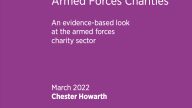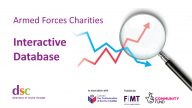Policy, campaigns & research, Armed Forces charities research
#CharityFact 3: Armed forces charities hold some cash to protect against loss of income
The third in our new weekly instalment of evidence on the armed forces charity sector, this week’s #CharityFact focuses on cash assets.
There are many myths and misconceptions about charities. Unfortunately, armed forces charities are no exception. At the Directory of Social Change (DSC), we believe you need two things to combat this: you need to know the facts and you need the evidence to back them up.
That’s why we’re bringing together the facts in short, weekly instalments. These facts are based on our new research, funded by Forces in Mind Trust.
This week, we’re looking at #CharityFact number three: Armed forces charities hold some cash to protect against loss of income.
Is cash the same as reserves?
Cash – or ‘cash assets’ as they’re called at the Charity Commission – refers simply to the money a charity has in its bank account.
A charity’s cash assets can form part of their reserves. But reserves are actually made up of various funds and types of assets, many of which are not cash and cannot be easily accessed.
Here, we focus just on cash. This is because, in principle, it can be more easily accessed than other forms of reserves.
We also focus on cash because that’s what people typically think of when charities have come under fire for having reserves. But it’s important to remember: they’re not the same thing!
How many armed forces charities hold cash?
Almost all armed forces charities have some cash in their bank account. To be precise, it’s around 98%.
We suggest this is likely to be an overestimate for the sector overall. The reason for this is that our calculations are based on data available only for charities with upwards of £500,000 annual income – and larger charities typically have more cash.
How can we put cash in context?
We could look at the amount of cash charities hold in pounds and pence. However, as armed forces charities come in all shapes and sizes, this is a bit like comparing apples and oranges.
One way to put cash assets in context is to ask, hypothetically: ‘In a crisis with no income, for how many months could the charity continue serving its beneficiaries with existing cash assets?’
This might seem extreme, but it has been a genuine question facing charities during the Covid-19 crisis.
How much cash do armed forces charities hold?
As shown in the interactive chart below, 111 of the 121 armed forces charities that have any cash assets can cover at least 1 month of expenditure – that’s about 92%.
Clicking over to the second button, you’ll see the dial drop down to 83. In other words, around 69% of armed forces charities have enough cash assets to cover at least 3 months of expenditure.
If you now select the button for at least 6 months of expenditure, the number of charities falls by around half to 41, or approximately 34% of armed forces charities.
Finally, there are 18 armed forces charities – around 15% – that could cover at least 12 months of expenditure using their cash assets.
What to make of this?
We have seen substantial variety in charities’ cash positions relative to their expenditure. This is because trustees develop policies on cash – and, more broadly, reserves – to meet the needs of their charity. As the Charity Commission put it: ‘There is no single level, or even a range of, reserves that is right for all charities.’
One relevant dimension can be differences in how much charities depend on public donations – this source of income can change quickly and unexpectedly. DSC’s research showed widespread falls in income from public donations during the Covid-19 pandemic.
We focused on cash in relation to expenditure to provide some simplicity. But there are, of course, limitations to this. For example, charities sometimes build up cash to cover planned costs – so their cash can’t actually be put to another use as in our hypothetical example.
Put simply, almost all armed forces charities have some level of cash in the bank. When income streams dry up, this can be vital to providing continued support to individuals and families.
Find out more
Don’t forget to download the full report for free. You can also share our accessible infographic with those in need of the facts.
Read the sequel to this article: #CharityFact 4: Armed forces charities’ income is mostly independent of the government.


